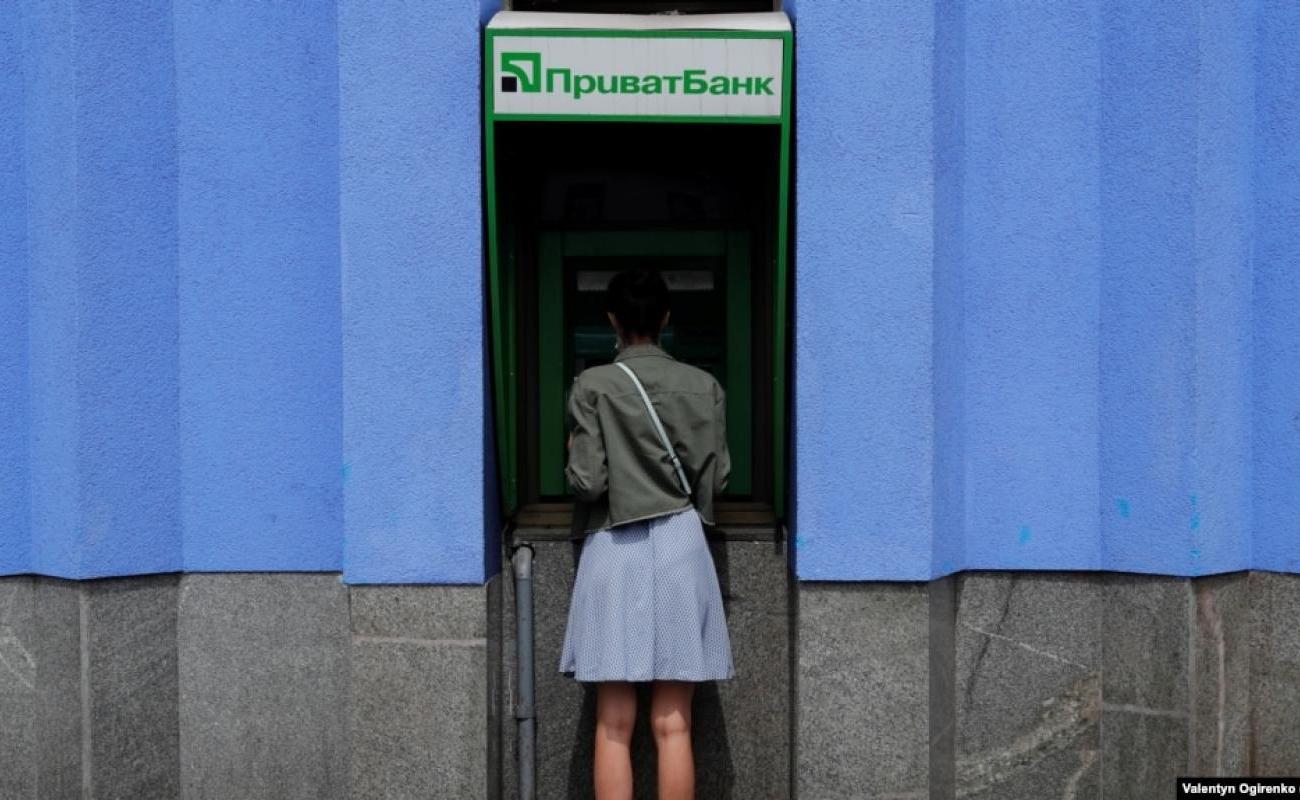Can Ukraine's Economy Withstand Russian Pressure? It's Better Prepared This Time Around.

As Russian massed tens of thousands of troops near the border with Ukraine last fall in a possible prelude to an offensive, military experts warned that invading forces would face a much stronger army than Kyiv possessed in 2014, when Moscow seized Crimea and backed separatist forces in the Donbas region.
While most analysts say that the far larger Russian military would prevail in the event of a major escalation, Ukraine’s armed forces have turned a corner: They are bigger, better trained, and better equipped than they were at the start of the war in the Donbas, which simmers on after more than seven years.
And what about the economy? In a similar fashion, experts say that despite its many structural problems, persistent corruption, and the impact of COVID-19, it is much healthier than it was on the eve of Russia’s aggression in 2014, enabling it to better cope with the problems triggered by Moscow’s mounting pressure.
“If you just look at the buffers -- Ukraine’s foreign currency reserves and budget deficit -- I think it is in good shape and the resilience has improved” compared with 2014, said Tatiana Orlova, an economist at the U.K.-based consultancy Oxford Economics.
In February-March 2014, when the pro-Western, anti-corruption Maidan protests pushed Moscow-friendly President Viktor Yanukovych from power, and Russia responded by seizing control of Crimea and fomenting separatism in the Donbas and beyond, Ukraine was already teetering on the verge of bankruptcy.
Yanukovych’s government had mismanaged the economy and squandered the nation’s foreign currency reserves to prop up the Ukrainian hryvnya. It ran a large budget deficit caused in part by subsidized natural-gas prices and a significant current account deficit fueled by the overvalued hryvnya.
As a result, the central bank had just $18 billion in foreign currency reserves by early 2014, less than the equivalent of three months of imports, and with billions of dollars in external debt soon coming due.
Russia’s aggression later that year helped push the Ukrainian economy sharply down. It contracted by one-sixth over the next two years.
Today, Ukraine has $31 billion in foreign currency reserves, as well as smaller budget and current account deficits thanks in part to reforms, including gas market liberalization.
Ukraine’s foreign currency reserves are equivalent to about five months of imports, well above the three months experts recommended to reduce the threat of a financial crisis from external shocks.
“Ukraine no longer has this big twin deficit problem, so it's much easier for it to actually avoid sovereign default, even if the events follow a negative scenario,” Orlova said, referring to a possible invasion or attack.
A sovereign default occurs when a government is unable to pay its debts on time. A default makes it harder and more expensive for a country to borrow money in the future.
Whether or not Russia launches a new invasion, its military buildup may be part of an effort to destabilize Ukraine from within, including by undermining its economy, in the hope that President Volodymyr Zelenskiy’s government might weaken or collapse, potentially opening a path for more Moscow-friendly forces.
Russian President Vladimir Putin has repeatedly lashed out at Zelenskiy and his government, and parts of the political opposition advocate closer relations with Moscow. Earlier this month, Britain said it had information indicating that Moscow “is looking to install a pro-Russian leader in Kyiv as it considers whether to invade and occupy Ukraine.”
Russia recently cut off coal exports to Ukraine for power production in the midst of a global energy crunch, forcing Kyiv to source the world for additional supplies.
It has also reduced natural gas volumes crossing Ukraine into Europe by about half. Natural-gas transit generates an important source of revenue for Ukraine, totaling as much as $2 billion a year.
The threat of war has also put foreign investors on edge.
Yields on Ukrainian dollar debt have surged into the teens, making it prohibitively expensive for the country or its companies to borrow on international markets, potentially hurting the government’s ability to roll over debt that is coming due.
The hryvnya has lost more than 10 percent of its value since the Russian buildup began as foreign debt investors dump Ukrainian bonds. The national currency was trading at 28.6 to the U.S. dollar on January 28, near a record low.
Meanwhile, strategic foreign investors -- such as energy, manufacturing, and retail companies -- may put any planned investment in Ukraine on hold amid the crisis resulting from Russia’s military buildup and sweeping geopolitical demands, economists said.
Citizens could also seek to pull money from banks or convert to dollars, putting pressure on the banking system and currency. Ukraine earlier this month raised interest rates to fight inflation and shore up the currency.
And earlier this week, Ukraine said it would seek $5 billion from international organizations and countries to offset the impact of closed debt markets.
Nonetheless, Ukraine's economy can hold up much better today in the face of shocks caused by Russian aggression, compared with 2014, because it has carried out some crucial reforms over the years and significantly decoupled from its larger neighbor, economists said.
It also has the clear financial backing of the International Monetary Fund and Western governments.
Prior to 2014, Ukrainian banks had poor risk-control management and quickly failed when the country fell into a deep recession following Russia’s invasion.
The government has since cleaned up the sector and pumped money into lenders to make them more resilient to shocks, Orlova told RFE/RL.
It has also largely liberalized the natural-gas sector for both companies and households following decades of Soviet-style subsidization that burned a hole in the budget and choked off incentive for energy efficiency measures.
Ukraine today imports about 10 billion cubic meters (bcm) of gas, down nearly two-thirds compared with 2013, as higher prices from liberalization forced companies and households to cut consumption. The loss of control over Crimea and parts of two provinces in eastern Ukraine also account for part of the decline in natural-gas usage.
Ukraine, which has been seeking to reduce the Kremlin’s leverage over its economy, now imports natural gas via its western neighbors rather than directly from Russia.
As a result, Russian trade with Ukraine has fallen significantly, reducing the threat of supply chain disruptions, Tymofiy Mylovanov, a former economy minister who is now president of the Kyiv School of Economics, told RFE/RL.
Ukraine has failed to carry out many policy changes that Western governments and international institutions such as the IMF say are needed to further strengthen its economy.
China and Poland have surpassed Russia as Ukraine’s largest country trading partners.
Ukraine, though, is still connected to the same power grid as Russia and Belarus, so it remains dependent on them in the case of a shortfall.
Ukraine plans to synchronize its electricity transmission system with the European Union by 2023, a move that will increase its energy security and further weaken the Kremlin’s hand, Mylovanov said.
Despite its progress in some areas like banking, gas consumption, and more recently agriculture land reform, Ukraine has failed to carry out many policy changes that Western governments and international institutions such as the IMF say are needed to further strengthen its economy.
Anders Aslund, an analyst at the Stockholm Free World Forum who closely follows Ukraine, said in a recent blog post that the country needs to implement the long-delayed reforms of the judiciary, the Security Service (SBU), and the Prosecutor-General’s Office, as well as improve management of state-owned companies that loom large over the economy.
Ukraine extended its financing program with the IMF last year, allowing it to tap funds should international markets not reopen soon for the country.
The United States and Europe have also said they are prepared to help Ukraine financially to stem the impact from Russia’s military buildup and the threat of additional military action beyond the continuing conflict in the Donbas.
“Just as we’re bolstering Ukraine’s security, so, too, are we looking for how we can support its economy beyond the significant assistance we’re already providing. Our European allies and partners are doing so, as well,” U.S. Secretary of State Antony Blinken said on January 26.
Blinken did not lay out the details of the financial assistance the United States is contemplating.
The U.S. government backed bonds issued by Ukraine in early 2014, at a time when international markets were essentially closed to the country.
Elina Ribakova, an economist at the International Institute of Finance in Washington, said debt markets could reopen for Ukraine within half a year if Russia pulls back its forces.
“If we have credible de-escalation, I can see investors almost forgetting this six months from now. This is part of the reality of investing in Ukraine or Russia,” she said.

